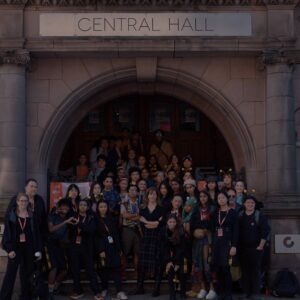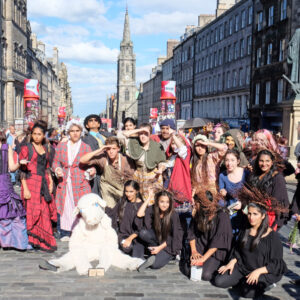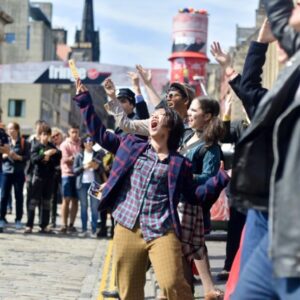This story originally appeared in the Fall/Winter 2019 issue of Harker Magazine.
Earlier this year, a contingent of upper school students traveled to Scotland for the Edinburgh Festival Fringe, the world’s largest arts festival. Putting on a pared-down version of “Urinetown,” the 2019 upper school spring musical, the show was set up, performed and torn down in just 90 minutes, a daunting task for any theater troupe, much less a group of high school students performing in a venue very different from their usual environs. Nevertheless, the productions went smoothly and received praise from local media, such as EdinburghGuide, which raved, “This particular ensemble from the award-winning high school conservatory The Harker School blows you away with their character work and synchronicity, a display well beyond their years.” But while the performances garner most of the attention-grabbing pull quotes, there’s no show to be had without the crew, whose skills at running a show on time and glitch-free were learned in Harker’s technical theater program.
As a discipline, technical theater comprises a massive range of theatrical aspects essential for a successful show. “Technical theater supports the productions we do at Harker,” said upper school technical theater teacher, and the school’s production manager, Brian Larsen. “So kids involved in technical theater work on stage crew, move things around, construct, paint and install scenery, operate the lights, soundboard and follow spots, help with costuming, putting things together.”
Such a broad scope naturally attracts students with diverse interests, but Larsen noted that it is rare that students enter the upper school program knowing exactly what they want to do. “If a student comes in and is very focused on being a sound technician, we want to try and help them with that track as much as possible,” he said. Far more common are students who discover their interests on their own after some experimentation. “What we’ve discovered is kids come here and they try a couple of things and go, ‘ooh that’s interesting,’ and they get a little more involved in that component,” Larsen said. “But we don’t tend to get a lot of kids who come through the door and say, ‘I’m a lighting designer.’ We’ve had those students, we’ve had those kids who did lighting outside of our organization … which is tremendous, but on the whole, we try to have the kids have as many opportunities as possible.”
In order to help students better find these opportunities and discover the aspects of technical theater they want to pursue, the performing arts department soon will offer a class on the study of technical theater, which recently received UC approval. “The study-of class will be very broad-based,” said Larsen, who also noted that the Rothschild Performing Arts Center provides a suitable space for experimentation. “The kids will have a lot of opportunities to try all manner of things. [Rothschild] is a large lab, so we’ll have a lot of opportunity for them to get immersed in things and try things out.”
The beginnings of Harker’s technical theater program date back to 1996 when Larsen joined the middle school faculty to teach theater production. With the start of the upper school and the opening of what is now the lower school campus two short years later, the challenge of teaching two classes on separate campuses compelled Larsen to seek another teacher for the grade 6 class. Danny Dunn was then brought on to teach grade 6 while Larsen taught at the middle and upper schools. When the middle school campus opened in 2005, Dunn moved her class to Blackford. Under her direction, more hands-on elements were added and her students began working shows, the first of which was a major task for a group of young students. “The very first show that the sixth grade students ever crewed was one of the great big huge shows that we put on to welcome the Tamagawa visitors,” Dunn said. Though there was some concern that such a young and inexperienced crew could take on the task, “Sure enough, the kids did a great job,” Dunn remembers.
The move to Blackford left Dunn with no tech theater students at the lower school to work on that campus’ productions. “So I started the fifth grade program because I’d lost all my tech kids at the lower school.” Dunn’s classes began as a primer on theater production: “how a theater works, jobs in the theater and whatnot,” she recalled.
She later began inviting students to help build sets on the weekends. “Parents would drop their kids off and we would just have a great time and build sets,” she said. “That became very popular and still is to this day.” True to Dunn’s vision, students in grade 5 perform a great deal of hands-on work, building props, sets and occasionally costumes. “If we’re doing the picnic show here with middle school actors, we might need 100-plus Robin Hood hats,” Dunn said.
Tools of the trade are also learned early on in the program, including the use of (and safety precautions with) power tools used to create the sets as well as soundboard and light board operation, and even special effects makeup and stage combat. “My goal is to have them not just help the grown-ups do it but for them to take ownership of an aspect of the performance,” Dunn said.
At the middle school, technical theater is offered as a series of electives, starting with a grade 6 design class that teaches the fundamentals of creating a scene using elements of scenery, lighting and sound. One exercise has students design a scene from the stage adaptation of the famous children’s novel “The Phantom Tollbooth.” Every aspect of the scene, including props, lighting, costumes and special effects, is conceptualized and critiqued.
Middle school students who wish to continue their studies have the option of taking an elective in theater production and design for grades 7 and 8, taught by Paul Vallerga, the middle school technical director, who has also been Harker’s primary set designer for 17 years. It is here that students begin working on elements that are used in major middle school productions. “The first day of class, one of the things I try to tell them is that, besides just the tech theater aspect, what I want them to learn from the class is that any time they’re watching anything – a TV show or movie – realize that everything you see is on purpose,” said Vallerga said. “Even if the decision was just, this where I’m going to put the camera to shoot those trees, somebody decided that’s what they want the audience to see.” Vallerga, who also spent 20 years with the now-defunct California Theatre Center, has students practice designing sets using William Gibson’s “The Miracle Worker” as a basis. “I try to teach them a few things about traffic patterns,” he said, noting the times he has had to coach students against “making a doorway that’s a foot wide.”
Further bolstering the middle school tech theater offerings is the afterschool technical theater class open to all middle school students, which includes weekly workshops in a variety of disciplines, including prop-making, makeup, costume construction and fight scene choreography.
By the time she arrived at the upper school, junior Geneva Devlin had spent considerable time in the technical theater programs at other campuses. Although she didn’t feel as enthusiastic about the craft as she once had in middle school, she nevertheless signed up to be a member of the crew for “42nd Street,” the first spring musical to be produced at the Rothschild Performing Arts Center. “It was my first time doing tech for an actual show and I loved it,” she said. “Being able to bond with my fellow techies and dance along backstage was so much fun, I didn’t want it to end.” She later joined the Harker Conservatory’s certificate program for technical theater and has since been joining the crew for shows whenever possible.
The upper school fortunately provides students with a wide range of learningopportunities, given the ambitious size and complexity that the productions often achieve. Certificate candidates are also prioritized when it comes time to decide which positions on the crew will be filled, especially “if there is something in particular they either are really interested in or haven’t done yet,” said Larsen. “So we make that available to them first and then we open it up to the other students to sign up for positions that interest them.”
Similar to how certificate candidates in other disciplines are required to act as crew members, so too must technical theater students perform in a show as part of their track in order to see how these different elements of crafting a show are affected by and complement one another. “You have to do both sides so you can see what that experience is,” Larsen said. “So you understand what a performer going through rehearsal is experiencing.”
Shanna Polzin ’10, who is now working as a production manager and stage manager in New York City (the Bryant Park Tree Lighting is her favorite event to work each year), first became fascinated the inner workings of the shows she performed in as a sixth grader, when a few of her friends began working on the crew. “In high school, I was part of the Conservatory program as a dancer, and we had a requirement of two technical positions,” she said. “That was my first experience with being a backstage crew member, as well as a follow spot operator.”
Though she spent most of her time at Harker as a performer, the program taught Polzin to appreciate just how much the crew works to make a show possible. “From a very young age, Mr. Larsen taught me the importance of tech theater and how no show can happen without the crew,” she said. “So while I was predominantly a performer, I was always taught to notice, appreciate and respect the tech side of things.”=
Although Polzin did not receive her certificate in technical theater, she cites the experience she gained at Harker as a factor in helping her find her current career, “from being aware of all the parts that go into putting on a show, to the work ethic, attention to detail and time management skills that get developed in all Harker students, to the general love of performing and making an audience happy,” she said.
“Ideally, if a student starts in fifth grade then takes the sixthgrade design elective, then works with Paul in the seventh and eighth grade and then does the Conservatory program with Brian, by the time they leave they should be able to get a job in theater no problem, if that’s what they want to do,” said Dunn. “But even kids who only take part of the program still enjoy it. They like being part of a show without having to act.”
Dunn also has noticed that technical theater provides a way for students who are reticent or less enthusiastic about acting to enjoy the process of putting on a show, which occasionally leads them to discovering an appreciation for performing they were previously unaware of. “I notice in middle school there’s a whole lot of being too embarrassed to perform,” she noted, “so students who are not comfortable being in the spotlight or putting themselves out there can dress all in black and blend into the scenery but still be completely part of the show, part of a cast or crew, part of the experience.”
The opening of the Rothschild Performing Arts Center presents a number of exciting opportunities for the technical theater program, which is already set to grow with the addition of the Study of Technical Theater class next year.
“It’s done two huge things, and neither of them can be understated,” Larsen said. The first is the presence of a fully equipped facility located on the same campus where upper school technical theater students spend most of their days, which removes the disruption of having to travel to a different campus to work. “The kids know right after school, they can come to the building, they can rehearse, they can build, they can do all the things that are inherent in being on the campus,” Larsen said.
The second major change is how the facility further connects the upper school’s performing arts department to the culture of the campus. “It’s not that much of a big deal now if students catch a ball game, grab a bite to eat and come see our show,” Larsen said. “It’s all contained within the culture of the upper school; it’s right here.”
It’s also had benefits for the middle school, which for the time being has a space entirely its own that it no longer has to share with another campus. “We don’t have to kick the drama teachers out of their rooms for a week, and say ‘hey, these are our [upper school cast’s] dressing rooms now,’” Vallerga said. For his part, Vallerga also looks forward to using the facilities at Rothschild to create props and scenery for middle school productions, as well as bringing middle school students to the upper school to work on the elements of their shows.
Whatever potential the new building holds for the program, there are students who remain in love with the process and its people above all. “I enjoy getting to learn something new each time I crew. I further my knowledge and gain more experience,” said Devlin. “I also really love bonding with all of the actors. Being able to interact and learn from the professional tech community that works at Harker is like a dream.”








